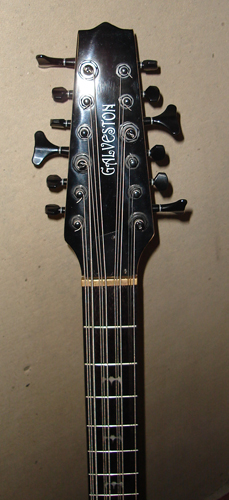HOW many strings are on that thing?

If you really want to get the audience’s attention, you pull out a bass like this one. It’s a 12 string bass (yes, you read that correctly.) It is actually sort of like a combination of a 4-string bass and a 12-string guitar; the strings are tuned in groups. There are four “root” strings for the standard bass guitar pitches of E-A-D-G. Then a pair of matching strings tuned one octave up are placed in close proximity to the main strings. So what you end up with, in the case of my instrument, is a tuning as follows (where a capital letter indicates the root string and lowercase letters are the octaves):
The groups of strings are called “courses” and they are fretted and strummed/plucked in groups of three. What results is a HUGE, ringing, naturally chorused sound that can just fill the room.
Here’s a clip from the second album from Second Story – a bit of “Truth Is…” which features the 12-string.
You’ve probably heard a 12-string before – Jeff Ament used one for the intro and outro riff (and much of the song) in “Jeremy”; playing a repeating figure complete with octaved harmonics. It’s the signature line on the song. Another popular user of the 12-string is Doug (dUg) Pinnick of King’s X; he’s used it a number of times over the years, and since King’s X is a trio, having the extra “girth” that a 12-string provides comes in handy, I’m sure.
As for me, I used it in two Second Story songs – “Truth Is…” and “Wise” – it also makes a brief appearance in the Din Within song “The Bottom/Between Two Lives.” And I intend to use it a good bit more on the next Din Within album.
 My particular bass is made by “Galveston,” which is one of several names slapped on instruments that come to the States from China under several brand names (including several store brands). While the bass is quite solid, the stock electronics sucked big time, so I replaced them with some Seymour Duncan actives and a Bart preamp – the new pickups really emphasize the “chimey-ness” of the octaves, and yet they really helped to fill out the bottom end, too. And the Bart preamp really gives the bass a lot more headroom, which is necessary for a bass that creates so much bandwidth. Altogether, quite a worthwhile upgrade, even though I had to do a little work with the Dremel to make it happen.
My particular bass is made by “Galveston,” which is one of several names slapped on instruments that come to the States from China under several brand names (including several store brands). While the bass is quite solid, the stock electronics sucked big time, so I replaced them with some Seymour Duncan actives and a Bart preamp – the new pickups really emphasize the “chimey-ness” of the octaves, and yet they really helped to fill out the bottom end, too. And the Bart preamp really gives the bass a lot more headroom, which is necessary for a bass that creates so much bandwidth. Altogether, quite a worthwhile upgrade, even though I had to do a little work with the Dremel to make it happen.
It’s not for everybody (or every song, to be sure) but the 12-string is a pretty awesome tool to have in your arsenal. I’m sure it intimidates most of the guitarists I know!







